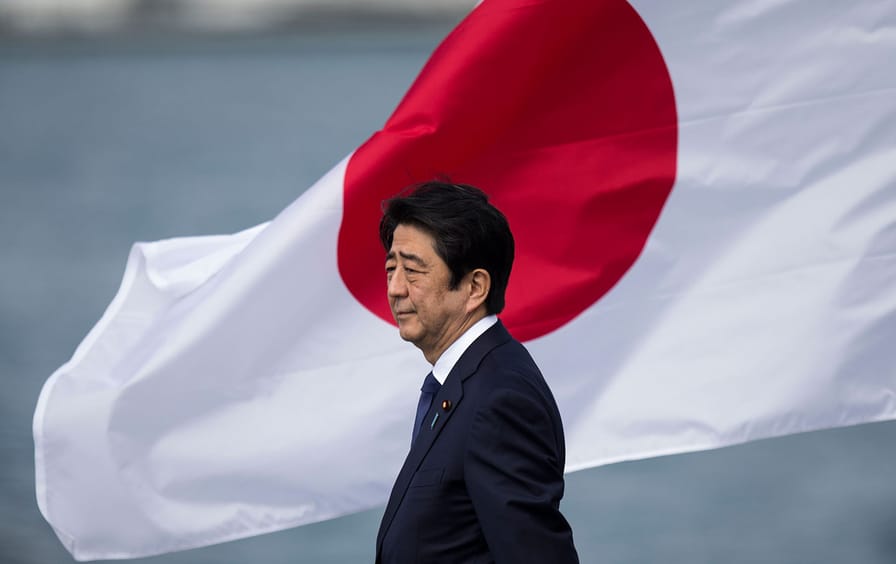The Misremembering of Shinzo Abe
In the wake of the former prime minister’s assassination, his antidemocratic legacy has been whitewashed—and his death has renewed calls for revisions to Japan’s pacifist Constitution.
By Lisa TorioTwitter
YESTERDAY 5:00 AM




 Print
PrintBookmark

Former Japanese prime minister Shinzo Abe at Joint Base Pearl Harbor in Honolulu, Hawaii, on December 27, 2016. (Kent Nishimura / Getty Images)
Subscribe To The NationSubscribe now for as little as $2 a month!
TOKYO, JAPAN—In the days following the assassination of Shinzo Abe on July 8, heartfelt tributes to the late former prime minister filled television screens, showing fellow party members speaking tearfully in front of reporters and his supporters laying flowers at the site where he was shot. Even the mainstream newspapers, which had been more critical of Abe prior to his death, remembered him as a leader who, despite being controversial, was fiercely determined.
However, the narrative around Abe’s legacy put forth in the media following the assassination overshadows just how unpopular Abe was with the public in his final years. Despite becoming the longest-serving prime minister in Japan’s history, his administration was mired in multiple corruption scandals and alleged cover-ups, which led his approval ratings to drop to an all-time low. When Abe announced his resignation in August 2020, citing health reasons, he was already deeply unpopular with Japanese voters, who were critical of his handling of the coronavirus outbreak.
During Abe’s eight-year reign as leader of the ruling Liberal Democratic Party (LDP), Japan also saw one of the most conservative, right-wing administrations in its postwar history, garnering widespread condemnation for its authoritarian tendencies. A fierce proponent of neoliberalism both at home and abroad, Abe promoted policies centered around maximizing corporate profits and cutting social services, worsening the already dire living conditions endured by part-time and contract workers in Japan. Under the nationalist slogan of “Taking Back Japan,” Abe’s administration also pushed for “moral education” in schools, placing emphasis on Japan’s “beautiful traditional national character” and pressuring textbook publishers to omit passages mentioning crimes committed by the Japanese Imperial Army in the years prior to and during the Second World War.
Top ArticlesREAD MOREIt Can Happen Here: A White Supremacist CoupThat Succeeded
Perhaps Abe’s most controversial initiative was his effort to remilitarize Japan by revising the postwar Constitution, particularly Article 9, dubbed the “peace clause,” which renounces Japan’s participation in war. Despite massive nationwide protests, Abe’s administration rammed through a set of security bills authorizing offensive military operations overseas under the premise of “collective self-defense.” His administration also passed an “anti-conspiracy” bill that expanded the ability of law enforcement agencies to target activists and ordinary citizens with accusations of “preparing to commit a crime,” which many saw as an attempt to quell dissent ahead of his efforts to revise the Constitution.
WORLD

CAN CHILE’S RADICAL NEW CONSTITUTION SURVIVE A VOTE?
Natacha López
As Dr. Koichi Nakano, a professor of political science at Sophia University in Tokyo, wrote in a 2019 article titled “The Leader Who Was ‘Trump Before Trump’”: “The Abe administration is…rejecting the rules of the democratic game, denying the legitimacy of its opponents, curtailing the civil liberties of dissenters and tolerating or encouraging some forms of hate speech—all precisely the indicators of budding authoritarianism.”
Even though the suspect in Abe’s assassination has stated that his act was not politically motivated, Abe has been treated as somewhat of a martyr by the nationalist right, including his political successors. In the parliamentary elections that were held just two days after the assassination, the LDP and its partners secured a supermajority in the upper house, which now allows them to begin discussions on revising the Constitution in the parliament. The election victory has undoubtedly emboldened members of the ultranationalist faction of the LDP to “carry on” Abe’s legacy. “It was the former prime minister’s will that we continue on the road toward constitutional revision,” LDP policy chief Sanae Takaichi, one of Abe’s protégés, told reporters after her party’s win. “With my colleagues, I want to protect the conservative fire he sparked.”
While it goes without saying that the assassination of Abe deserves condemnation, one cannot help but see the irony in the framing of Abe’s assassination as a “barbaric act aimed to destroy democracy” in light of the corruption scandals and authoritarian policies that mark his legacy. What is perhaps even more disturbing is the outpouring of messages from world leaders and commentators in the West who see Abe not only as a victim of an attack against democracy but also as a fervent “defender” of democracy himself.
CURRENT ISSUE
View our current issue
Subscribe today and Save up to $129.
In his statement on Abe’s assassination, US President Joe Biden called Abe a “champion” of the alliance between Japan and the United States, stating that Abe “cared deeply about the Japanese people and dedicated his life to their service.… Even at the moment he was attacked, he was engaged in the work of democracy.” In an article in The Atlantic titled “Shinzo Abe Made the World Better,” David Frum wrote, “Through it all, Abe consistently advanced a vision of the Pacific region that was safe for democracy.”
We could attribute this kind of whitewashing to the general ignorance shared by politicians and commentators about what goes on domestically in countries outside their own. However, the depiction of Abe as a proponent of “democracy” begins to make sense if we consider the word in its historical context.
Japan’s defeat in the Second World War put a halt to the country’s colonial expansion in Asia—driven by its imperial aspirations to compete against Western powers—and marked the beginning of the country’s occupation by the US military, which lasted until 1952 (the United States continued its occupation of Okinawa, formerly the Ryukyu Kingdom and annexed by Japan in 1879, until 1972). In 1946, Japan’s current Constitution—which came to be known as the “pacifist Constitution”—was drafted by US occupation officials, with an intent to dismantle the Japanese military and strip the nation of its capability to carry out another war.
However, US policy on Japan took a major turn in 1948, as US officials grappled with the new realities of the Cold War. The United States traded its efforts to punish Japanese imperialists and democratize postwar society for a new push intended to build Japan into a “conservative, anti-Communist bastion,” as the The New York Times described it, against the rising threat of Communist China.
DONATE NOW TO POWER THE NATION.
Readers like you make our independent journalism possible.
In 1953, the United States made a request to the Japanese government to strengthen its military capabilities and simultaneously introduced a foreign aid package in accordance with the Mutual Security Act of 1951. For Washington, Japan’s remilitarization meant a stronger US military alliance in Asia as well as a cost-saving strategy for the US military in the long run. For Japan, a country with much of its resources depleted from the war and in desperate need of foreign currency, the request presented itself as an opportunity not only to revitalize Japan’s economy with US support but also to rebuild Japan’s military. It was under such US pressure that the Japanese Self-Defense Forces were formed in 1954.
Abe’s LDP came into power with the help of the CIA and became, as Tim Shorrock describes in his 2015 piece in The Nation, “one of the most subservient political allies the United States has ever had.” Abe’s maternal grandfather, Nobusuke Kishi, who was deemed a “Class A war criminal” in the early years of the occupation, led the LDP and became prime minister in 1957. He ratified a revised version of the US-Japan Security Treaty, which allowed the US to set up military bases across the country.
For Abe, who sought to carry on his grandfather’s legacy, the “pacifist Constitution” was the last remaining obstacle to Japan’s becoming an “equal partner” in its alliance with the United States. Abe pressed on despite massive nationwide protests against the constitutional revision. His administration also deployed hundreds of riot police to crack down on protesters in Okinawa, who have continued to stage nonviolent protests against the presence of US and Japanese military bases on the islands, including the construction of a new military base in Henoko.
With the Biden administration calling China “the most serious long-term challenge to the international order,” Japan’s remilitarization is a key part of what Washington calls its effort to “defend democracy” worldwide. Shinzo Abe is remembered as a proponent of democracy and a “friend” precisely because he fell in line with this vision. But what Biden and others call “democracy” comes at the cost of crushing any real chance at democracy for people at home. As the LDP prepares to push for a revision to the Constitution, this current moment gives us, if anything, a chance to question for whom this “democracy” is intended—and what a true vision of democracy in Asia and in the world looks like.
Editor’s Note: This article initially referred to Nobusuke Kishi as Shinzo Abe’s paternal grandfather. In fact, he is Abe’s maternal grandfather. The article has been corrected.
Lisa TorioTWITTERLisa Torio, a former Nation intern, was the Kopkind/Nation fellow in 2016.
To submit a correction for our consideration, click here.
For Reprints and Permissions, click here.
COMMENT (1)

00:1101:17
No comments:
Post a Comment